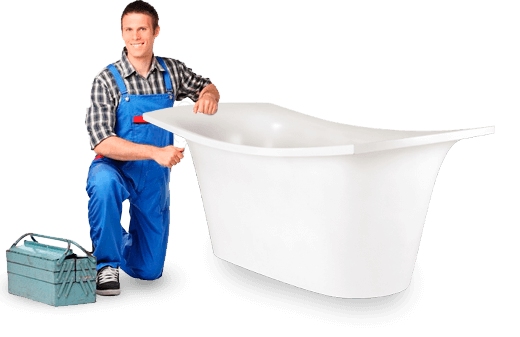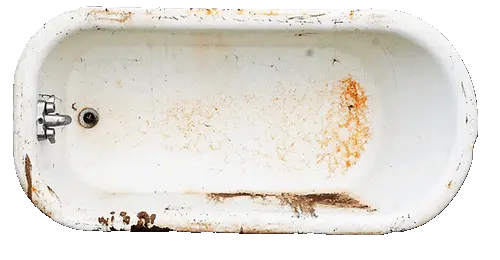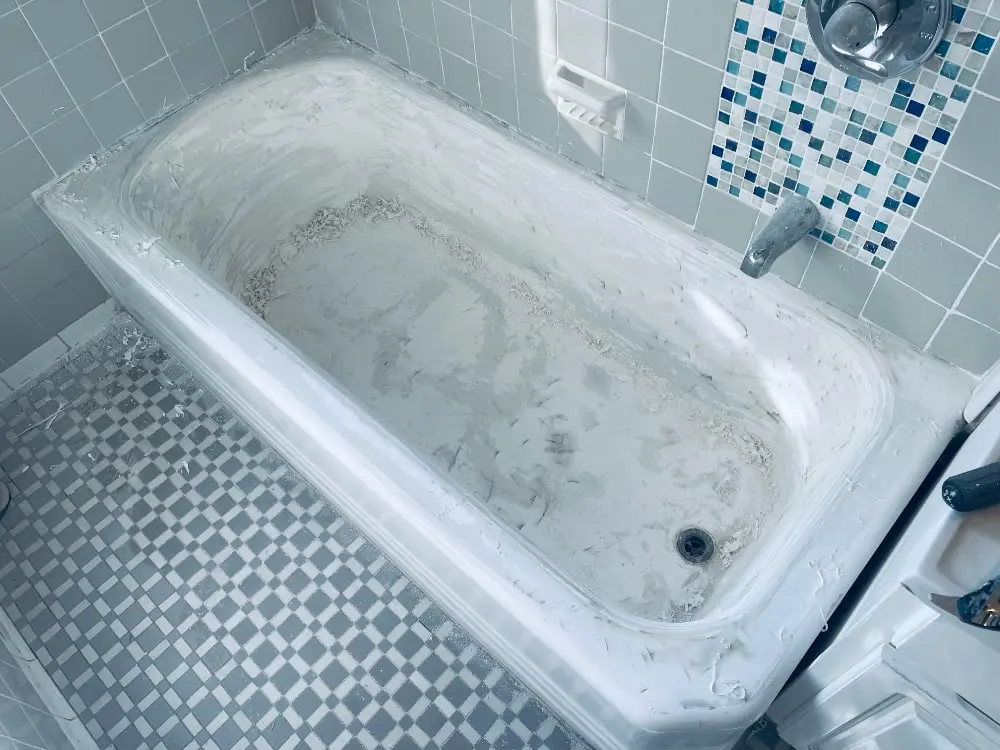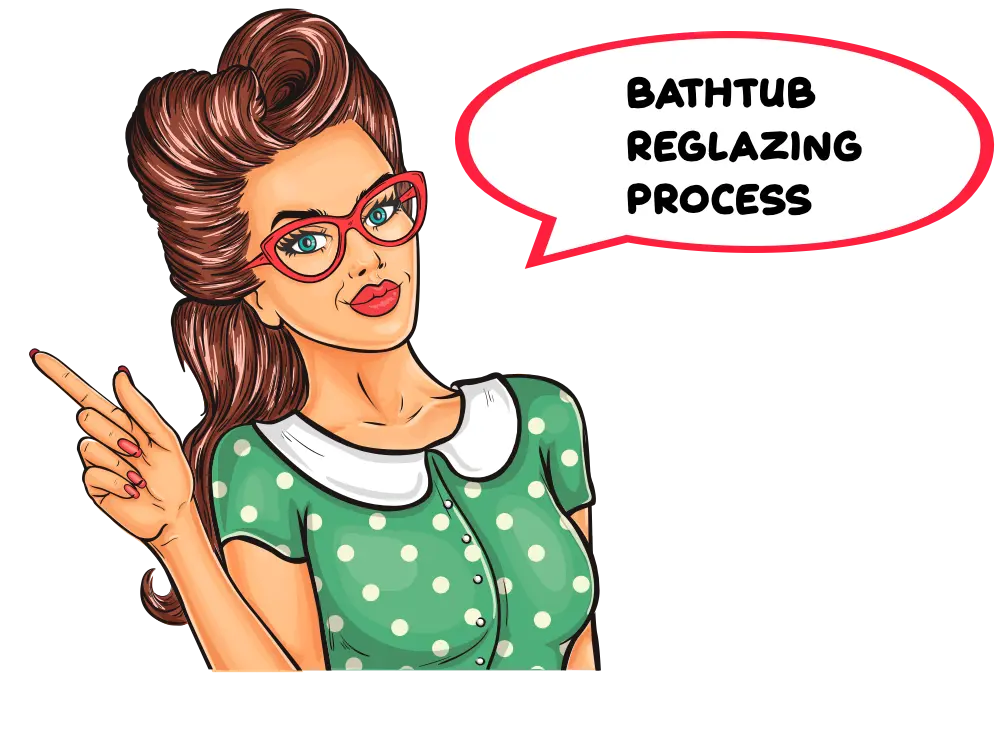Bathtub Enameling (Spraying)
When cast iron tubs start to wear out and lose their smooth, clean finish, they can be refinished with different methods and materials. One option is the spray-on method using epoxy enamel. This is often used in industrial applications, but that is much different than the spray-on enamel used to refinish bathtubs in residences.
Learn more about the material and method used for renovating bathtubs using the spray-on method with enamel. We’ll take a deep dive into the subject and explain the pros and cons so you can make the best choice for restoring your bathtub.

Cast iron tubs are strong, durable and heavy, making them a reliable choice for a bathroom fixture. However, over time the finish can start to fade. In addition, damage, rust and cracks can ruin its appearance. Because of the weight and sturdiness of the cast iron base, these tubs are not easily removed and replaced.

Most cast iron tubs have an enamel coating that, despite being hard on the surface, is actually quite fragile. Impact from dropped objects, water stains, and age can all take a toll and cause the finish to lose its luster.
Cracks, chips and peeling are common, and water or rust stains start to build up.
Besides being unattractive, a cracked or peeling finish can harbor harmful microbes and cause scratches and scrapes to your skin. The rough finish also makes it difficult to clean dirt, rust and stains from the surface.
An unsightly bathtub detracts from the look of your entire bathroom. Removing and replacing the tub can be an expensive, complicated process, but a simpler, more affordable option is refinishing it. There are different materials available, but here let’s explore the spray-on method using epoxy enamel.
Enamel Refinishing Kits
One popular option for DIYers to refinish a cast iron tub is to apply a new coating of enamel to the surface. Kits are widely available for a fairly low cost that property owners can use to cover surface imperfections and damage and restore a smooth finish to worn-out bathtubs. These are available online and at home improvement stores.
These kits include the chemicals and paints you need to complete the project, but you may have to buy the tools separately: brushes, rollers, sprayers, personal protective equipment, etc. There are a wide variety of brands and prices available.

Cost of Spray-On Enamel in New York
| Spray-On Application | Pour-On Application | |
| Durability | ||
| Speed of service | ||
| Process completion | ||
| Odorless | ||
| Drying Time | ||
| COST | Starting at $259 | Starting at $259 |

DIY Refinishing With Enamel
Refinishing your tub using spray-on or roll-on enamel can be a DIY project, but it requires a lot of work and attention to detail. It also has other inherent pitfalls that property owners should be aware of before taking on the task. These include environmental hazards as well as handling plumbing work.
Due to the chemical nature of the materials, the home or apartment should be vacant to avoid exposure and fumes. The rooms should be well ventilated, and the workers applying the enamel should take necessary precautions as recommended by the manufacturer.
The bathtub should be disconnected from the water supply, and the drain also needs to be removed.
Following are the basic steps for DIY bathtub refinishing.
-
The first step in enameling a cast-iron bathtub is to prepare the surface. The old layer of enamel needs to be removed, and the surface is carefully smoothed.
Sandpaper can be used by hand with an abrasive powder, but that can be very time-consuming. A sanding disc with a drill can speed up the process. In either case, it creates a lot of dust that has to be cleaned up. And eye protection should always be used when working with power tools.
-
If the damage is deeper than the enameled surface, those areas must be filled and repaired.
The entire surface of the tub needs to be even since the enamel refinishing material won’t even out any variations (high spots or low spots).
-
Dust and other small particles need to be removed, and then the surface has to be washed, dried completely, and then treated with a degreaser. This helps assure a stronger adhesion of the enamel.
-
Epoxy enamel is applied. Each layer can be applied with rollers or brushes (these are most commonly used by DIYers), but a sprayer can also be used.
The first layer is the primer. This is applied in as thin a coat as possible. It needs to dry for 20 minutes before applying the next layer, which is the enamel. Usually two to four layers of enamel are applied, but more can be added if desired.
-
After all layers have been applied, they are allowed to dry completely. The time it takes to dry can vary based on several variables, including the number and thickness of the layers.
-
After the layers are completely dry, the water line and drain can be reconnected. Before using the bathtub, it should be thoroughly and carefully cleaned using soap and a soft sponge.

Pros of Spray-On Enamel
When considering methods and materials for refinishing your bathtub, epoxy enamel is a well-known option because it has been around a long time. It is fairly easy for beginners to work with, and it gives predictable results.
Are there other advantages?
-
The refinished surface can last for a year with proper care and maintenance. This means you can delay the purchase of a new tub and the associated expenses of materials, labor, and possibly repair of surrounding fixtures.
-
Working with epoxy enamel is not difficult, so even DIYers with no experience can complete the job without hiring a professional.
-
The material is affordable. If you’re looking for a quick renovation (such as when renting or selling a property), it can be worth it to use spray-on enamel for a short-term fix.
-
The tub does not have to be removed and replaced. This can save a lot of time and be a simpler choice.
-
Epoxy enamel is usually the cheapest material for refinishing the surface of your tub. If cost is the only factor, enamel will fit the bill.
Cons of Spray-On Enamel
Spray-on epoxy enamel may be a quick and easy option, but it does not fix damage or provide a long-lasting, durable finish. It’s becoming outdated because of the disadvantages.
Before making a decision, it’s important to consider the drawbacks to using epoxy enamel:
-
Even though the process is fairly easy, it is time-consuming. Several layers need to be applied, and each layer has to dry before applying the next one.
-
Epoxy enamel has a strong chemical smell, so it important to use personal protective equipment when applying it. The smell can permeate the entire home or apartment, so the premises needs to be vacated while work is in progress.
Ventilation should be maintained while applying the enamel. This can be done by opening a window, but that’s not always possible or practical. Cold or hot weather, dust, or other issues can make it impractical. And in many cases there may not be a window to open.
For these reasons, property owners that are looking for environmentally responsible options have found that epoxy enamel is not the best choice for them.
-
Results last for only a year, and that’s only when using great care and meticulous maintenance. Enamel has the shortest durability among bathtub refinishing methods.
If your tub gets more than average use (for example, with a large family) or if it is exposed to more harsh treatment (such as being used for children and pets), that could significantly shorten the lifespan of the finish.
-
The epoxy enamel coating is not as thick and pliable as other methods, so it doesn’t level the surface as well. If there are deep cracks or damage, it will seep into the grooves and leave an uneven surface that could have bumps, ridges or bare spots.
-
Epoxy enamel takes a long time to dry. Besides the time it takes to dry between coats, the finished surface needs up to a week to dry completely. That can be very inconvenient for busy people who are unable to use the bathtub during that time.
There are other methods that dry in much less time, so epoxy is losing popularity when compared to more advanced materials.
-
Enamel is relatively fragile and easily damaged. Metal containers should not be placed in or around the tub to avoid scratching or marring the surface. Dropped objects, such as bottles or brushes, can also cause damage.
Sharp changes in water temperature can cause staining. Because enamel is porous, it absorbs dirt and rust and gets dirty easily. Cleaning after each use is recommended to maintain the white surface.
-
Epoxy enamel may seem like a reliable choice since powder enamel is used on cast iron for industrial applications.
However, the materials differ significantly from each other: the factory enamel is much thicker and more reliable, while the epoxy enamel used for refinishing bathtubs in homes and apartments is much more fragile. Even the slightest impact can damage the surface.
-
Considering the short duration of spray-on enamel, it does not provide the best return on your investment. Although the up-front cost may be less because the material is cheaper, the process is time-consuming, and after only about a year it will have to be refinished again.
That means more money, more time, and more inconvenience year after year, which is hardly a good investment when you consider all that is involved.

Are There Other Options?
Yes. New technology offers leading-edge materials and methods that give you all of the benefits of spray-on enamel but without the disadvantages.
Bathtub reglazing using ArmoGlaze is a leading choice among property owners and professional refinishers alike. It’s an environmentally-friendly, odor-free material that provides a superior finish and long-lasting results. The cost is affordable, especially if you consider that the reglazed finish can last 7-15 years.
It’s resistant to fading, cracking, peeling and microbes. It can withstand daily wear and tear without losing its luster, and it won’t chip easily, even with accidentally dropped objects. Best of all, the process takes only 3-4 hours to complete, and your tub is completely dry and ready to use in 24 hours.
Although the process is not time-consuming, it does require technical skills and expertise that first-time users may not have. To obtain the best results and to prevent accidents or damage to your bathtub or property, we recommend professional application by experienced craftsmen.

Learn more about the pour-on application method and see if it’s right for you.
